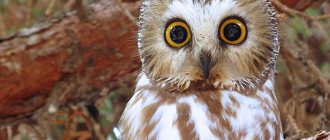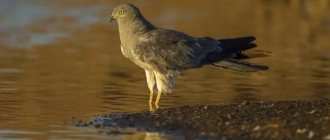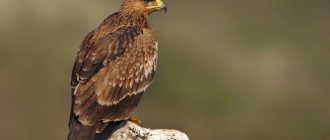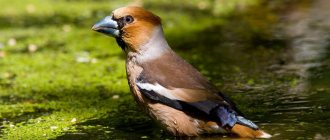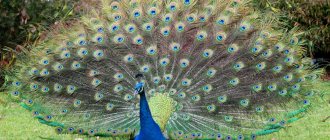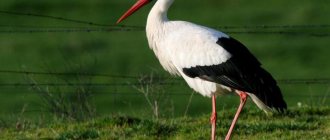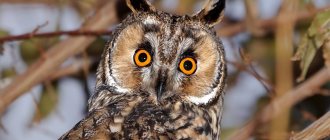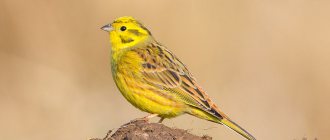The harrier is a diurnal predator of the family Accipitridae. It can glide close to the ground without a single sound at an extremely low speed and grab unwary voles, pied birds carelessly leaning out of their holes, chicks of field and wading birds that have barely learned to fly, as well as amphibians. It is not easy to elude the sharp claws on the long legs of the harrier: they tenaciously and accurately extract prey from the tall grass. The harrier is a bird of open space; it nests widely throughout the planet, but does not cross the polar line.
A harrier on a hunt hovers silently and low above the ground and looks out for prey.
Bird of prey harrier: photo and description
In nature, there are more than 5 species of this feathered predator. The most common is the marsh or reed species. This bird has a gray color with a brownish tint. White (gray) stripes can be seen along the surface of the wings and back. The plumage of the bird is uniformly colored with one color, in some areas only individual darker or, conversely, lighter highlights of shades are distinguished. The piebald harrier has strong, tenacious long legs and a powerful long tail made of hard elastic feathers. The harrier is a bird with a rather sharp, curved beak and incredibly tenacious claws. This is a predator! And that's it.
If we evaluate the dimensions of the bird’s body, we can conclude that the hen harrier and other varieties of this breed of birds occupy middle positions in the list of the hawk family.
Marsh Harrier: difference between males and females
This breed of predators has pronounced gender differences. Males have a compact structure and a more miniature body. The body length of an adult male reaches 44-48 centimeters. The female has a more impressive body size - 48-55 centimeters. The wingspan of males is 10 centimeters less than that of females. The female specimen boasts a wingspan of 120 centimeters.
There are significant differences in the color of individuals depending on gender. The gray harrier is, rather, a male of the said bird of prey. It is the male individual that is characterized by a light gray color with an even whiter belly. The female is brown-variegated in color with pronounced dark curly stripes.
Characteristic differences can also be found in the behavior of harriers of different sexes. During the mating season, the male actively conquers the female. The female becomes incredibly aggressive during the period of hatching her offspring. She zealously protects her brood and reacts sharply to any danger. The protective impulse sometimes triples the power of the bird. She can easily drive away a fox, a steppe eagle, or a dog from her offspring.
Marsh Harrier in flight
Nutrition
The flight of a hunting marsh harrier is quite spectacular. It floats low on wings that form a shallow v-shape. The bird's legs often hang down. That is, full readiness for attack is demonstrated. This style of flight allows you to quickly descend and pick up prey from the surface of the water or land. An approximate list of what the marsh harrier eats :
- ducklings and other chicks,
- small fish and birds,
- rodents, mostly young muskrats,
- reptiles, amphibians.
Marsh harriers, especially during the feeding period, try to attack adult waterfowl. These attempts are rarely successful. Only when the duck or sandpiper is sick or injured. Birds nesting in a colony actively defend themselves and do not allow marsh harriers and other hawks to come close.
Where does the harrier bird live?
The harrier is a field winged bird that densely inhabits open landscape spaces. When choosing a forest area, the harrier will settle somewhere on the edge. These birds like the open steppe zone.
The distribution range of this bird is very wide. Harrier lives in Europe and America. Africa, Australia, Ukraine, Russia, Belarus. It is difficult to meet this feathered predator only in the distant polar regions.
The harrier is a freedom-loving and proud predator! What bird can be disturbed in the meadow? Definitely not a harrier. The fact is that this is a real predator that uses its capabilities to the fullest! The bird prefers to soar high in the sky and makes a steep dive when it sees its prey.
Marsh Harrier in all its glory
Breed varieties
There are more than a dozen species of this bird in the world. But it is worth mentioning separately the most common types of harrier.
Eurasian Hen Harrier (circus cyaneus)
A large representative of its species with a characteristic brown-gray color. The Hen Harrier is distributed throughout Eurasia. It feeds mainly on mice.
Steppe Harrier
This bird is classified as an endangered species. The steppe harrier is listed on the IUCN Red List. A bird with a characteristic bluish color. A large predator - a representative of birds - lives in various regions of the mountainous Caucasus and steppe regions of Russia. It feeds on mice, lizards, and other small animals that live in its area of distribution.
Photo of the steppe harrier
Asian piebald harrier
Breeds in Transbaikalia, Amur region, Moldova. You can find it in China. Large bird with black and white coloration. Other characteristics of this variety differ little from other representatives of the breed.
Gray Harrier
Lives in Argentina, Chile, Brazil, Peru, Colombia, Uruguay. This variety boasts a classic beige-brown color with gray streaks. The size of representatives of this species is large. Corresponds to the classic characteristics of the breed.
Photo of gray harrier
Meadow Harrier
The smallest representative of the species! An adult meadow harrier may not exceed 41-44 cm in length. The body weight of such a bird is from 335 to 450 grams.
The meadow harrier is widespread in northeast Africa, Eurasia, from the Atlantic to Altai.
Photo of meadow harrier
Links[edit]
- Oatley, Graham; Simmons, Robert E.; Fuchs, Jerome (2015). "Molecular phylogeny of harriers (Circus, Accipitridae) suggests a role for dispersal and long-distance migration in diversification." Molecular phylogenetics and evolution
.
85
: 150–60. DOI: 10.1016/j.ympev.2015.01.013. PMID 25701771. - Lacepède, Bernard Germain de (1799). "Table of sous-classes, divisions, sous-divisions, orders and genres of Oise". Discours d'ouverture et de clôture du cours d'histoire naturelle
(in French). Paris: Plassans. clause 4. Page numbering begins with one for each of the three sections. - Mayr, Ernst; Cottrell, G. William, eds. (1979). Checklist of birds of the world. Volume 1 (2nd ed.). Cambridge, MA: Museum of Comparative Zoology. paragraph 316.
- Jobling, James A. (2010). Helm's Dictionary of Scientific Names for Birds. London: Christopher Helm. paragraph 109. ISBN 978-1-4081-2501-4.
- Hogg, John (1845). "Catalogue of Birds Observed in Southeast Durham and Northwest Cleveland". Zoologist
.
3
: 1049–1063. - "Looni in India: A Field Guide" (PDF). wwt.org.uk.
_ Wetland Link International. Retrieved January 27, 2022. - Etherington, Graham J.; Mobley, Jason A. (2016). "Comparison of molecular phylogeny, morphology and life history in Circus cyaneus reveals two distinct evolutionary lineages". Avian Research
.
7
. DOI: 10.1186/s40657-016-0052-3. - Griffiths, Carol S.; Barrowclough, George F.; Groth, Jeff G.; Mertz, Lisa A. (2007). "Phylogeny, diversity and classification of Accipitridae based on RAG-1 exon DNA sequences". Journal of Avian Biology
.
38
(5):587–602. DOI: 10.1111/j.2007.0908-8857.03971.x. - Fuchs, Jerome; Simmons, Robert E.; Mindell, David P.; Bowie, Rauri SC; Oatley, Graham (2014). "Lack of mtDNA genetic diversity in Black Harrier Circus maurus, endemic to South Africa". Ibis
.
156
: 227–230. DOI: 10.1111/ibi.12103.
What birds are similar to the harrier?
The harrier bird is a representative of the falcon family! This species of feathered predator has several brothers. There are also birds similar in description to the bright representatives of harriers.
Eagle - burial ground
Large bird of prey of the hawk family. It chooses steppe and forest-steppe as its habitat. It has similar habits to the harrier and a characteristic color.
Photo of Imperial Eagle
Snake eater
Another representative of this family. The large feathered predator is similar to the harrier in color, size, and some habits. However, this bird has completely different gastronomic preferences, which are easy to guess from the name.
Photo of the snake eagle bird
Steppe kestrel
From a distance it is easy to confuse it with the steppe harrier. However, upon closer examination it is clear that the similarity can be traced only in color, size and, more distantly, in body structure. The kestrel has a neater beak. The bird belongs to the same hawk family. However, it looks less like a predator than its previous relatives on the list.
If you look at a photo of a marsh harrier or another type of bird, it is easy to conclude that almost every member of the family is similar. But, each species and breed has its own differences, which are not limited to external qualities, but also extend to character, habits, and habitat.
Photo of the steppe kestrel
Nesting and offspring
Only the female is involved in the construction of the nest. She incubates the clutch. Nesting takes place below, in last year’s dry, coarsened grass, among tall growth. A marsh, steppe bird or meadow harrier will always choose an open area of terrain for nesting. The nest can be represented by neatly twisted branches with grass or an ordinary depression in the ground. Chick incubation time is 28-38 days. During this time, the female does not leave the nest and strictly guards the area around the home. The male brings food to the female. Seeing a male flying in the distance, the female quickly flies out of the nest and, simulating an air fight, takes food from the beak of the “faithful”. This theatrical performance is necessary for intimidation, so that not a single living creature would want to get closer to the laying site, and subsequently to the hatched chicks.
Marsh Harrier Nest
Lifestyle
The described migratory bird usually arrives at its habitat (nesting) at the end of April. The meadow harrier builds a nest on the ground in a damp meadow or near water. They are also found in reeds.
A clutch of 3-6 white eggs (sometimes with brown spots) occurs at the very beginning of May. The interval between egg laying is from one to four days. The eggs are incubated for about a month. It is noteworthy that at this time the male supplies the female and the emerging chick with food.
Usually the chicks leave the nest around the 35th day, but sometimes this can happen even 10-14 days after hatching. Even in particularly favorable years, the brood does not exceed 4 chicks. Young birds feed on lizards, small rodents, insects and small birds.
Interesting Facts
Harrier, a bird that was used as a basis for comparison in one of the sayings. White as a harrier! This is all thanks to the colorful appearance of the feathered predator. But it's not just about gray hair. If you look closely, you will notice that the appearance of an adult harrier resembles the face of a wise old man. Such a person certainly wears a beard and mustache and has a thoughtful, serious look.
This bird has a namesake. This is a representative of the ocean - the harrier fish. More precisely, the correct name for this fish is “moon,” but in common people it is called the namesake of the bird in question.
Don't take it off!!!
Listen to the voice of the marsh harrier
The audio tag is not supported by your browser. Close
Hunting
The meadow harrier is a bird that always hunts in open space, slowly flying around the selected area quite low above the ground. This way she usually hunts small rodents, small birds, lizards and insects.
Often, in order to catch its prey by surprise, the harrier moves in flight along the edges of tall grass. Having noticed its prey, it suddenly and unexpectedly falls down, extending its long claws forward. Moreover, unlike its counterparts (harrier or marsh harrier), this bird can grab its prey not only on the surface of the earth, but also in flight, in the air.
